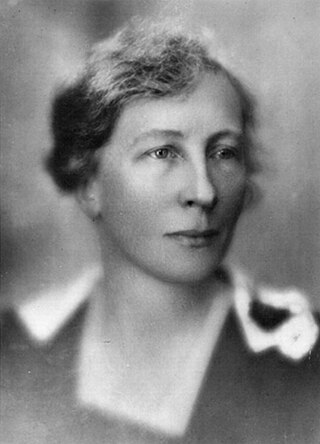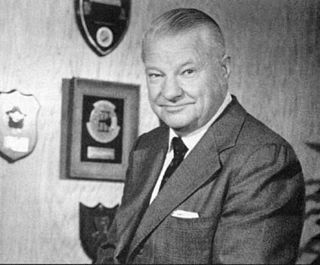
Lillian Evelyn Gilbreth was an American psychologist, industrial engineer, consultant, and educator who was an early pioneer in applying psychology to time-and-motion studies. She was described in the 1940s as "a genius in the art of living."

Donald Oscar Pederson was an American professor of electrical engineering at the University of California, Berkeley, and one of the designers of SPICE, a simulator for integrated circuits that has been universally used as a teaching tool and in the everyday work of circuits engineers. The IEEE Donald O. Pederson Award in Solid-State Circuits is named in his honor.

SRI International (SRI) is a nonprofit scientific research institute and organization headquartered in Menlo Park, California, United States. It was established in 1946 by trustees of Stanford University to serve as a center of innovation to support economic development in the region.

The South Dakota School of Mines & Technology is a public university in Rapid City, South Dakota. It is governed by the South Dakota Board of Regents and was founded in 1885. South Dakota Mines offers bachelor’s, master’s, and doctoral degrees.
Maurice Anthony Biot was a Belgian-American applied physicist. He made contributions in thermodynamics, aeronautics, geophysics, earthquake engineering, and electromagnetism. Particularly, he was accredited as the founder of the theory of poroelasticity.

Curtis Raymond Carlson was president and CEO of SRI International from 1998 to 2014.

Robert Lee "Bobby" Satcher Jr. is an American orthopedic surgeon, chemical engineer, and former NASA astronaut. He participated in two spacewalks during STS-129, accumulating 12 hours and 19 minutes of extravehicular activity. Satcher holds two doctorates and has received numerous awards and honors as a surgeon and engineer.

George Zames was a Polish-Canadian control theorist and professor at McGill University, Montreal, Quebec, Canada. Zames is known for his fundamental contributions to the theory of robust control, and was credited for the development of various well-known results such as small-gain theorem, passivity theorem, circle criterion in input–output form, and most famously, H-infinity methods.
Behzad Razavi is an Iranian-American professor and researcher of electrical and electronic engineering. Noted for his research in communications circuitry, Razavi is the director of the Communication Circuits Laboratory at the University of California Los Angeles. He is a Fellow and a distinguished lecturer for the Institute of Electrical and Electronics Engineers. Among his awards, Razavi is a two-time recipient of the Beatrice Winner Award for Editorial Excellence at the 1994 and 2001 International Solid-State Circuits Conferences. In 2017, he was elected as a member into the National Academy of Engineering for contributions to low-power broadband communication circuits.
George W. Housner was a professor of earthquake engineering at the California Institute of Technology and National Medal of Science laureate.
Capt. Willard Franklyn "Bill" Searle Jr. USN (ret.) was an American ocean engineer who was principally responsible for developing equipment and many of the current techniques utilized in United States Navy diving and salvage operations.
Frank P. Incropera is an American mechanical engineer and author on the subjects of mass and heat transfer. Incropera is the Clifford and Evelyn Brosey Professor of Mechanical Engineering at the University of Notre Dame, Indiana, US. A Fellow of American Society of Mechanical Engineers, Incropera is known for his contributions to the field of heat transfer, especially in the context of radiation transfer in scattering-absorbing media and double diffusive convection. He has been listed as an ISI Highly Cited Author in Engineering by the ISI Web of Knowledge - Thomson Scientific Company, and a Highly Ranked Scholar by ScholarGPS.

Clarence Leonard "Kelly" Johnson was an American aeronautical and systems engineer. He is recognized for his contributions to a series of important aircraft designs, most notably the Lockheed U-2 and SR-71 Blackbird. Besides the first production aircraft to exceed Mach 3, he also produced the first fighter capable of Mach 2, the United States' first operational jet fighter, as well as the first fighter to exceed 400 mph, and many other contributions to various aircraft.
William Alden Edson was a scientist and engineer specializing in vacuum tube oscillators, radar, antennas and microwave technologies. His work spans universities, research institutions and commercial ventures. He taught at Illinois Institute of Technology, Georgia Institute of Technology and Stanford University.

Harry Bolton Seed was an educator, scholar, former professor at the University of California, Berkeley. He was regarded as the founding father of geotechnical earthquake engineering.

Steven Patrick Chappell is an American aerospace engineer. He is a Technical Lead & Research Specialist for Wyle Integrated Science & Engineering at NASA's Johnson Space Center (JSC) in Houston, Texas. He is helping to define and execute the research needed to optimize human performance in next-generation spacesuits and extra-vehicular activity (EVA) systems. Chappell served as an aquanaut on the NASA Extreme Environment Mission Operations 14 crew.

Mary Golda Ross was the first Native American female engineer. She was also the first female engineer in the history of the Lockheed Corporation. She worked at Lockheed from 1942 until her retirement in 1973, where she was best remembered for her work on aerospace design. She was one of the 40 founding engineers of the renowned and highly secretive Skunk Works project while at Lockheed Corporation. Throughout her life, Ross was dedicated to the advancement of young women and Native Americans in STEM fields. Ten years after her death, in 2018, Ross was chosen to be depicted on the 2019 Native American $1 Coin by the U.S. Mint celebrating Native Americans in the space program.

Raymond J. Leopold is one of the three engineers who in late 1987 conceived of and later designed the Iridium satellite constellation, the first realization of global, wireless, personal communications.
James F. Gibbons is an American electrical engineer and academic administrator. He is credited with starting the semiconductor device fabrication laboratory at Stanford University that enabled the semiconductor industry and created Silicon Valley.











